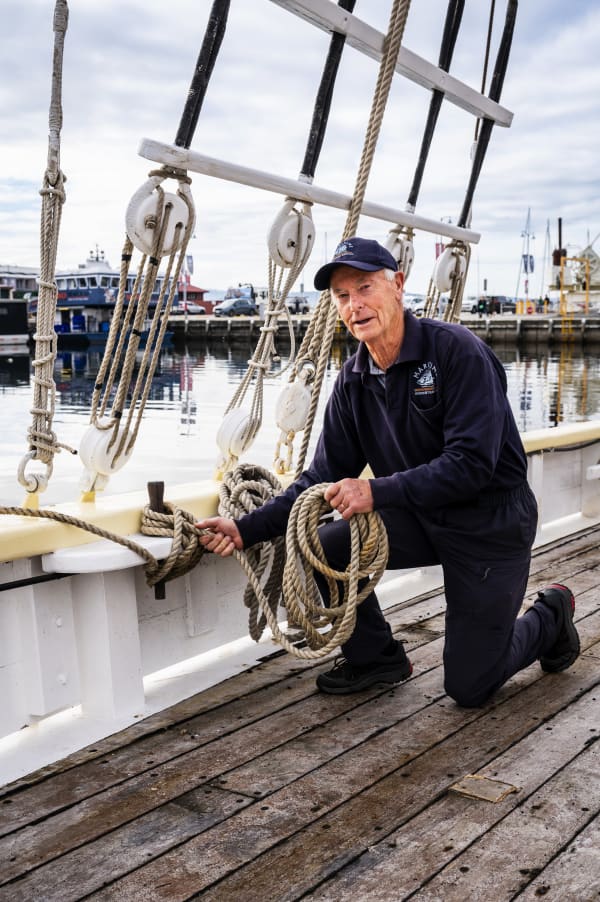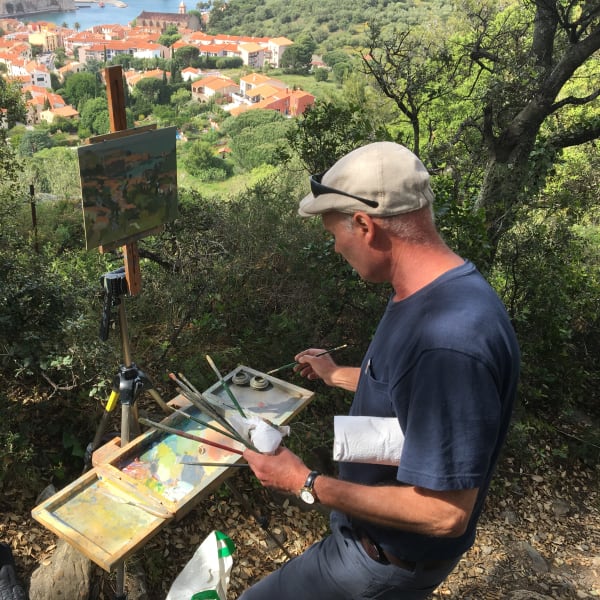Have you been to see the Queen?
She’s right there in the heart of Hobart, welcoming visitors every Saturday morning.
Stately and elegant, she waits, her white hull shimmering in reflection on the waters of Constitution Dock. May Queen belongs to Tasmania – to all Tasmanians. She’s a truly Tasmanian queen, built on the Huon River from timbers specially selected in the forest nearby, and launched in 1867 as a trading ketch. Her working life spanned 105 years. Such a long time for any vessel, and for a sail-trader carting heavy cargoes, it is extraordinary.
writer JANET FENTON photographer PEN TAYLER
Bob Chesterman, descendant of the timber merchants who owned May Queen for more than 80 years, welcomes us aboard. Bob is one of a band of carers who maintain the May Queen in trust for Tasmania. As we step onto the broad decks, we imagine life on board, freighting cargo in south-east Tasmania; hold and deck loaded with sawn timber, hull creaking, russet sails aloft. There would have been sunshiny days, foam glittering in the wake, gannets plunge-diving nearby. Then shivery days of relentless rain, uncomfortable given the scant shelter on board before a wheelhouse was built. Crew needed to be on deck to handle those sails.
Standing in the stern near the wheel, we are at the very spot depicted in the iconic post-card “Christmas dinner aboard the May Queen, 1896”. The crew of three sit around the fire-pot, enamel pannikins in hand, indulging in a boiled pig’s head for their Christmas repast (delectable!) “My grandmother would have cooked that for them,” chuckles Bob Chesterman. For the crew, it would have made a welcome change from mutton, biscuits, bread and fish caught on the line they towed behind.
Down we go into the “captain’s cabin”, so small, so spartan. A functional chart table is on one side and a narrow bunk on the other. An engine was installed in here in 1924, further crowding the space, but providing a surface for a table. Bending to avoid clunking our heads on heavy deck beams, we manoeuvre forward. This is the hold. This wide space represents May Queen’s purpose.

May Queen was one of the many Tasmanian trading ketches (locally called barges) which were essential for freighting timber, produce and goods on our waterways. This was the only way to go in times before reasonable roads, days barely imaginable from our stance in a world of highways and heavy truck freight. The trading ketch design evolved from flat-bottomed Thames barges, and before the advent of motors these vessels were powered by the wind. Tall masts carried vast sails, large for the size of the boat. Speed was essential, time meant money – pay was calculated on the quantity of cargo delivered.
With the centreboard raised, these barges could manoeuvre into shallow estuaries, dodging mud flats and reefs in fickle winds. When the wind dropped, crews resorted to other means of propulsion; poling, or hauling with kedge anchors. May Queen's cargo was anything and everything, though typically about 50 tons of sawn timber stowed tightly into the hold and on deck by fit, strong men wearing no gloves (oh, the splinters!) but leathery hardened hands.
We move forward in the hold while Chesterman points out old, time-worn ribs and frames with newer ones alongside, added for strength. Dim light plays on the frames, the heavy bones of the boat, and a smell of work, of damp, of timber and years of time pervades the air. A de-humidifier now keeps the ravages of damp at bay. Right in the bow are the crew's bunks, one on each side, even narrower than the captain's. Wooden pulley-blocks, rusty spikes and other artefacts from May Queen's history are displayed for the visitor.
And what a history! After a century of work on the waterways, May Queen has some stories to tell, of broken masts and spars, sails overboard, groundings, piracy, sinking (twice) and collisions (five). With so many boats using the waterway, collisions were not uncommon and usually resulted in damage of one sort or another, but after one collision with a whale – which lifted the stern up out of the water for a few seconds – both parties went on their way undamaged.
There were sinkings. One was very nearly the end for May Queen. In 1888 she was caught in a violent summer squall off the mouth of the Huon River and sank in 31 metres of water. May Queen came to rest on a flat sandy bottom, sails still set. May Queen was a valuable vessel and salvage was worthwhile for her owners, the Chestermans. After a month underwater she was dragged across the seafloor to shallower water and raised, with little damage.
 Then there were the races. Before you leave, glance upwards. A “Golden Cock” perches on the masthead. This is a replica of the award presented to winners of the annual trading ketch race, a highlight of the Hobart Regatta during the trading barge era. May Queen established a reputation for speed, winning 13 times, coming second 10 times and third three times. They were a competitive lot, those sail-trader skippers and crew.
Then there were the races. Before you leave, glance upwards. A “Golden Cock” perches on the masthead. This is a replica of the award presented to winners of the annual trading ketch race, a highlight of the Hobart Regatta during the trading barge era. May Queen established a reputation for speed, winning 13 times, coming second 10 times and third three times. They were a competitive lot, those sail-trader skippers and crew.
These adventures and the story of her conservation are told in Kerrison and Johnson's book, SV May Queen: a grand survivor (Forty South Publishing, 2014). A survivor she certainly is. After her working life, the vessel could have rotted away like most of her kin, but as Australia's oldest sail-trading vessel and the third oldest vessel of her type in existence, ship-lovers deemed her a key part of world maritime history and too significant to loose.
Several waves of conservation ensued and the project must have seemed overwhelming at times. Shipwright Ken Jones, contracted at one stage, was philosophical. “You just need to find the start. There might be a thousand jobs, but once you find the beginning, just do the jobs in the right order, one at a time …
“It felt important to me to provide skilled assistance in preserving the heritage and integrity of such a unique wooden trading ketch for future generations.” Since then, other shipwrights, including Mark Singleton, have worked on the conservation and, crucially, both unskilled and skilled volunteers have dedicated their time to keep this venerable survivor afloat. The camaraderie, sense of achievement and growing devotion to the vessel make work satisfying.
May Queen's significance was internationally recognised in 2003 with the prestigious International Maritime Heritage medal (Award number 22) from the World Ship Trust. She's rubbing shoulders with other significant vessels including Polly Woodside (number 7) and James Craig (number 23) in Australia. Number 17 is the famous clipper-ship Cutty Sark, no longer afloat, preserved as a museum ship in Greenwich, London.
May Queen is currently owned by the May Queen Trust, a non-profit organisation with the purpose of keeping the vessel "in trust for the people of Tasmania". The aim is to keep as much of the original structure of the vessel as possible, commensurate with safety requirements. The Maritime Museum of Tasmania has chartered May Queen for public display and is involved with routine maintenance. The central location with mooring space in Constitution Dock and regular access to the Domain slip-yard in Hobart for hull maintenance is provided with the support of Tasports.
Any queen requires her entourage and May Queen is no different. Volunteers are needed organising and promoting, and for many tasks such as deck-caulking, painting, carpentry, rigging and rope-work. If you’ve ever wondered what kept your forebears happy, this could be it — you’ll soon be adding futtock, trunnel and hawser to your vocabulary!
Do come and see the queen. Welcome aboard.










